 Thanks: 0
 Likes: 0
 Dislikes: 0
-
Removing slight DA haze/hologram
I've gotten rid of quite a few scratches and some spider webbing on my Tahoe but have some slight haze/hologramming when the sun hits it just right. I'm wondering what would be the best combo to get rid of this and leave a smooth, sealant-ready finish. In my arsenal I have:
Griot's Garage DA polisher
Lake Country CCS yellow, orange, pink, green, and red pads
Meg's Ultimate Compound, SwirlX, and Ultimate Polish
Thanks in advance!
-
Super Member

Re: Removing slight DA haze/hologram
I would try the green pad with Ultimate polish at speed setting 3-4
-
Junior Member
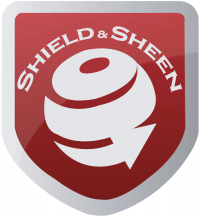
 Originally Posted by Evan.J

I would try the green pad with Ultimate polish at speed setting 3-4
What he said!
-
Re: Removing slight DA haze/hologram
First....
What are you finishing out with right now so we know what's NOT working?
Is this the factory paint or a re-paint?
 Originally Posted by tooshort_128

In my arsenal I have:
Griot's Garage DA polisher
pink, green,
Even though the pink and green pads are polishing pads they still offer some cut.
This,
 Originally Posted by tooshort_128

and red pads
Ultimate Polish
Do what I call troubleshooting. That is place a tape line down and buff using just the Ultimate Polish with the red pad on the 3-4 speed setting, make sure you mark your backing plate as you need the pad rotating, and make about 4-5 section passes on one side of the tape-line.
Next, wipe off the residue and inspect.
This side should be clear of any micro-marring or haze and look better than the other side, the before side. This is troubleshooting.
If it doesn't, then tell us what you're seeing. Ultimate Polish is very bubba proof for most paint systems.

-
Re: Removing slight DA haze/hologram
Video: Mark your backing plate to make it easy to see pad rotation
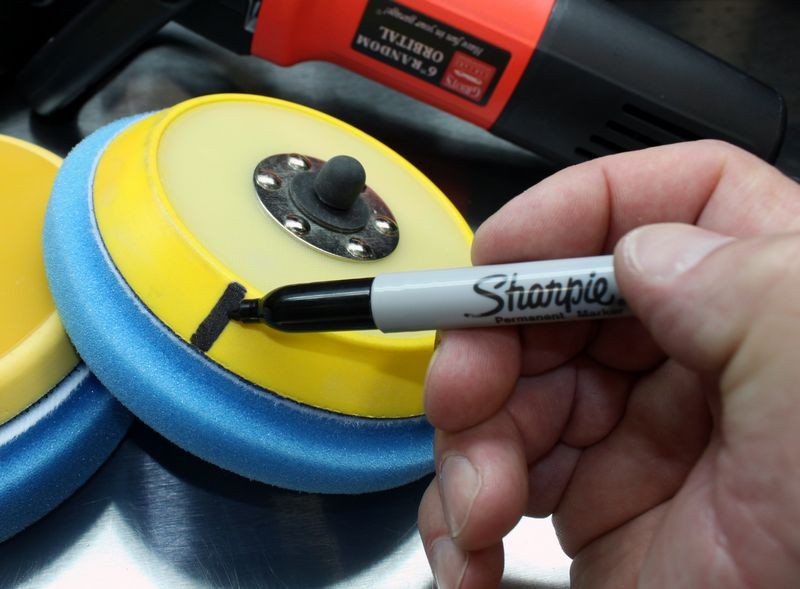
Here's a quick video that show how and why to mark your backing plate to see and monitor pad rotation while doing any correction or polishing steps.
The Griot's polisher is a beast so it should rotate a pad on the lower setting and the point being you need to use the high speed or 5-6 setting for final polishing.
Like I say,
Polishing paint is an art form, not a grinding process
With the PC you need the 5 setting minimum. The Meguiar's does a pretty good job of rotating pads down to the 4 setting but the Griot's can rotate THIN and small pads down to the 2-3 setting but you want more power than that to remove haze and polish out.

-
Re: Removing slight DA haze/hologram
Also, be sure to be cleaning your pads often to remove residue. This is a basic practice but if you don't know you need to do this then you might not be doing this.
I have met people that have buffed out entire cars without once ever cleaning the gunk that builds up on the face of the pad off the pad.
Here' my article on this topic. I think I re-write it and and post it new with a better title as it seems to be a forgotten "Best Practice".
Here's the point... if you don't clean the gunk building up on the face of your pad then it doesn't matter what brand of polish or type of pad you're using as you're going to be grinding the product residue and removed paint back into the paint and this can cause hazing or micro-marring.
Product Residue - That's spent product or product that's USED UP from you buffing with it.
Removed Paint - Anytime you abrade the surface you're removing paint and these tiny particles of paint build up with the spent product to become the GUNK on the face of your pad.
Here's the article....
Why it's important to clean your pads often...
ANYTIME you're abrading the surface whether you're using an aggressive cutting compound of an ultra fine polish, you have two things building up on the face of your buffing pad...
- Spent product
- Removed paint
You need to remove both of these substances from the face of the pad and the panel you're working on before you apply fresh product. If you don't,
- Adding fresh product to spent product and removed paint adulterates the fresh product, it also dilutes it.
- Buffing with a dirty pad will be more difficult.
- The product will cake-up on the face of the pad.
- The product will become gummy on the paint and hard to wipe off.
How to clean your pads and other options to make buffing clean again...
- You can scrub the face of the pad with a nylon brush like a pad conditioning brush or even a nylon toothbrush
- If using a Dual Action Polisher or a Rotary Buffer you can clean your pad on the fly with a terry cloth towel
- You can wash your pads in a bucket of water
- You can wash your pads in a sink under running water
- You can wash your pads in a pad washer
- You can switch to a clean, dry pad
- You can switch to a brand new pad
I just buffed out half the hood on an oxidized 1959 Cadillac and used the technique along with a nylon brush and it works adequately enough to allow me to work clean and get back to work quickly.
That's the whole idea behind cleaning your pad on the fly... you can remove a majority of the spent product and removed paint and then get back to running the buffer... buffing out an entire car already takes a l-o-n-g time... stopping to do some kind of pad cleaning procedure that isn't quick and easy keeps you from buffing on the paint.
Fast methods include,
- Pad Washers
- Cleaning your pad on the fly with a terry cloth towel
- Using a nylon pad conditioning brush
- Using a Spur if you're using a wool pad on a rotary buffer
Slow methods, (they might work well but they take you away from buffing on the car)
- You can wash your pads in a bucket of water
- You can wash your pads in a sink under running water

-
Re: Removing slight DA haze/hologram
If you haven't read this, give it a read-through, could also be something very simple causing the problem. In this article I list all the common problems people come across when using a dual action polisher.
DA Polisher Trouble Shooting Guide
When you're first starting out machine polishing and learning to use a DA Polisher it's common to have questions about your results and your results are directly tied to your technique.
Here's a list of the most common problems,
1. Trying to work too large of an area at one time.
2. Moving the polisher too fast over the surface.
3. Using too low of speed setting for removing swirls.
4. Using too little downward pressure on the head of the polisher.
5. Using too much downward pressure on the head of the polisher so the pad quits rotating.
6. Not holding the polisher in a way to keep the pad flat while working your compound or polish.
7. Using too much product or using too little product.
8. Not cleaning the pad often enough. Here's a list of the solutions in matching order,
1. Trying to work too large of an area at one time.
Shrink the size of your work area down. You can't tackle to large of an area at one time. The average size work area should be around 20" by 20". Most generic recommendations say to work an area 2' by 2' but for the correction step, that's too large. You have to do some experimenting, (called a Test Spot), to find out how easy or how hard the defects are coming out of your car's paint system and then adjust your work area to the results of your Test Spot. The harder the paint the smaller the area you want to work.
2. Moving the polisher too fast over the surface.
For removing defects out of the paint you want to use what we call a Slow Arm Speed. It's easy and actually natural for most people new to machine polishing to move the polisher quickly over the paint but that's the wrong technique. One reason I think people move the polisher too quickly over the paint is because they hear the sound of the motor spinning fast and this has psychological effect which causes them to match their arm movement to the perceived fast speed of the polisher's motor.
Another reason people move the polisher too quickly over the paint is because they think like this,
"If I move the polisher quickly, I'll get done faster"
But it doesn't work that way. Anytime you're trying to remove swirls, scratches, water spots or oxidation using a DA Polisher you need to move the polisher s-l-o-w-l-y over the paint.
3. Using too low of speed setting for removing swirls.
When first starting out many people are scared of burning or swirling their paint, so they take the safe route of running the polisher at too low of a speed setting but this won't work. The action of the polisher is already g-e-n-t-l-e, you need the speed and specifically the pad oscillating and rotating over the paint as well as the combination of time, (slow arm speed), together with the abrasives, the pad aggressiveness, and the downward pressure to remove small particles of paint which is how your remove below surface defects like swirls or scratches.
Removing below surface defects is a leveling process where you need the abrasives to take little bites out of the paint and to get the abrasives to take these little bites with a tool that uses a Free Floating Spindle Bearing Assembly you need all of the above factors working for you including a high speed setting.
4. Using too little downward pressure on the head of the polisher.
For the same reason as stated in #3, people are scared, or perhaps a better word is apprehensive, to apply too much downward pressure to the polisher and the result of too little pressure is no paint is removed thus no swirls are removed.
5. Using too much downward pressure on the head of the polisher so the pad quits rotating.
If you push too hard you will slow down the rotating movement of the pad and the abrasives won't be effectively worked against the paint. You need to apply firm pressure to engage the abrasives against the paint but no so much that the pad is barely rotating. This is where it's a good idea to use a permanent black marker to make a mark on the back of your backing plate so your eyes can easily see if the pad is rotating or not and this will help you to adjust your downward pressure accordingly.
Correct technique means finding a balance of applying enough downward pressure to remove defects but not too much downward pressure as to stop the rotating movement of the pad.
This balance is affected by a lot of factors like the lubricity of the product you're using, some compounds and polishes provide more lubrication than others and this makes it easier to maintain pad rotation under pressure.
Another factor that can affect pad rotation are raised body lines, edges and curved surfaces as anytime you have uneven pressure on just a portion of the face of the pad it can slow or stop pad rotation. This is where experience comes into play and experience comes from time spent behind the polisher.
6. Not holding the polisher in a way to keep the pad flat while working your compound or polish.
Applying pressure in such a way as to put too much pressure to one edge of the pad will cause it to stop rotating and thus decrease abrading ability.
7. Using too much product or using too little product.
Too much product hyper-lubricates the surface and the result is that abrasives won't effectively bite into the paint but instead will tend to skim over the surface. Overusing product will also accelerate pad saturation as well increase the potential for slinging splatter onto adjacent panels.
Too little product will means too little lubrication and this can interfere with pad rotation.
Again there needs to be a balance between too much product and too little product and finding this balance comes from reading articles like this one, watching videos an most important, going out into the garage and putting in time behind the polisher and as you're buffing with specific product and pad combinations, pay attention to pad rotation.
8. Not cleaning the pad often enough.
Most people simply don't clean their pad often enough to maximize the effectiveness of their DA Polisher. Anytime you're abrading the paint you have two things building up on the face of your buffing pad,
As these to things build up on the face of the pad they become gummy and this has a negative affect on pad rotating plus makes wiping the leftover residue on the paint more difficult. To maintain good pad rotation you want to clean your pad often and always wipe-off any leftover product residue off the paint after working a section. Never add fresh product to your pad and work a section that still has leftover product residue on it.
-
Re: Removing slight DA haze/hologram
And for a fast way to clean your pad on the fly as you work around a vehicle....
How to clean your foam pad on the fly
Video: How to clean your pad on the fly
Here's a technique I've been showing for years on how to clean your pad quickly so you can get back to buffing out your car.
How to clean your pad on the fly
The above technique works with any of the below DA Polishers,
Porter Cable DA Polisher
Meguiar's DA Polisher
Griot's Garage DA Polisher
Shurhold DA Polisher
If it works for you after watching the video, please post a comment to the thread for the video in the included link above.
Thank you.
When using a dual action polisher to remove below surface defects with any type of abrasive product youíre going to have two things building up on the face of the foam pad that you need to clean off.
- Spent residue - From the product youíre using.
- Paint - Small particles of paint that are coming off the car as you abrade the surface
If youíre working on a clear coat finish then keep in mind you wonít see the paint residue building up on the pad because the clear coat paint is clear. 
Make sense?
If youíre working on a clearcoat finish, all you're going to see is the color of the product that youíre using. For example if youíre using a white colored polish youíll see white residue building-up on the pad.
Now if youíre working on as single stage paint then youíll see the color of the paint on the car on the face of your foam pad,. For example if youíre working on a single stage yellow paint system then youíll see yellow paint on the face of your foam pad.
The important thing to understand is that as you work on the car with your polisher youíre going to be removing a little paint and thereís going to be used-up product and paint building-up on the face of the foam pad. It's important to clean this gunk off your pad often.
So the question is, how to you clean this gunk off the pad?
The answer is thereís a number of ways to clean your foam pad, the three most common are,
- Pad Washer
- Nylon Brush or Pad Cleaning Brush
- Terry Cloth Towel
Out of the 3 options listed above, cleaning your pad on the fly is probably the most popular because itís fast, and most people have a terry cloth towel in the linen closet that they can use to clean the pad.
The best way to clean a pad is with a pad washer but before you can use a pad washer you must first own one. Pad washers are worth their weight in gold if you buff cars out with any kind of regularity. If however youíre just buffing out your own personal cars, then chances are you donít own a pad washer but chances are very good you do own a terry cloth towel or two that you can use to clean your pads on the fly.
Brushes work good if youíre using a rotary buffer but the only way you can use one with DA Polisher is to turn the polisher off, hold the polisher and pad in such a way that the pad wonít spin and then rub the brush over the face of the pad to scrape off the residue.
While this works, it means turning the polisher off, (now you're not buffing out the car, remember the time issue?) and grabbing your brush and then brushing the pad. Nothing wrong with this but when you consider how long it already takes to do the cleaning step, (about 4-6 hours for an average size car and thatís if your good at this and if you work fast and donít take any breaks. So stopping the polisher and using a brush to clean the pad works but itís not as fast or effective as using a terry cloth towel.
The whole idea and success behind the cleaning your pad on the fly technique is in that it allows you to clean your pad quickly, (thatís the on the fly part), and then quickly get back to work.
Again, buffing out an entire car using a dual action polisher from start to finish is an all day job. There is no time for lollygagging. If you lollygag or take long breaks, you either wonít get the job done in one day or youíll sacrifice doing a quality job during the cleaning step in order to get to the waxing step so you can put the car back into service. 
So letís take a look at how-to clean your pad on the fly
Cleaning your pad on the fly is where you take a terry cloth towel, usually a medium size hand towel works best, you fold it in two and then simply hold the towel against the face of the pad and then turn the polisher on and use your hand thatís holding the towel to push the towel into the foam. This will act to draw any excess liquid out of the foam and any excess residue off of the face of the pad.
This is me using the Clean your Pad on the Fly Technique to clean my pad on the fly as we removed the oxidation off this Neon.

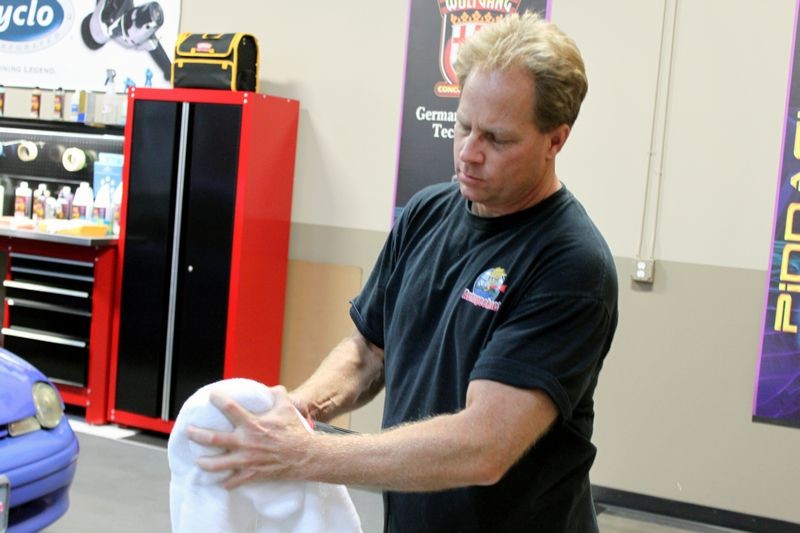
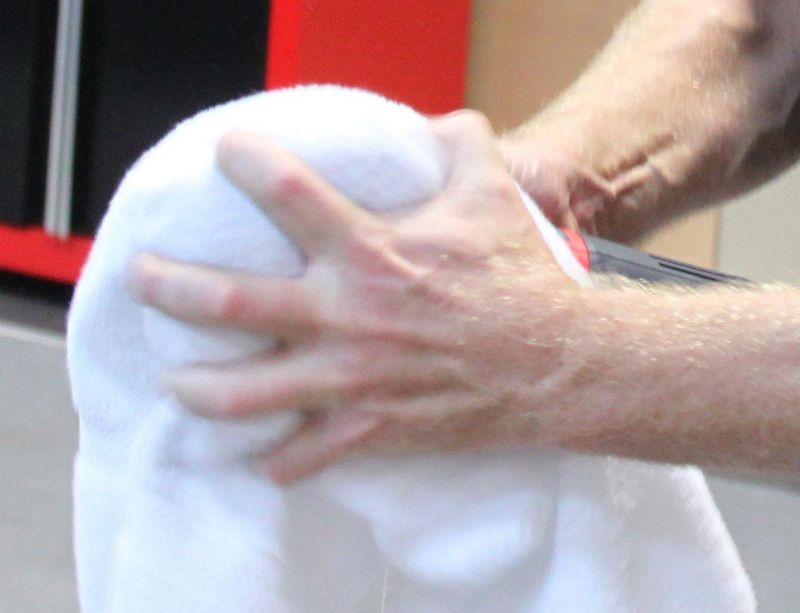
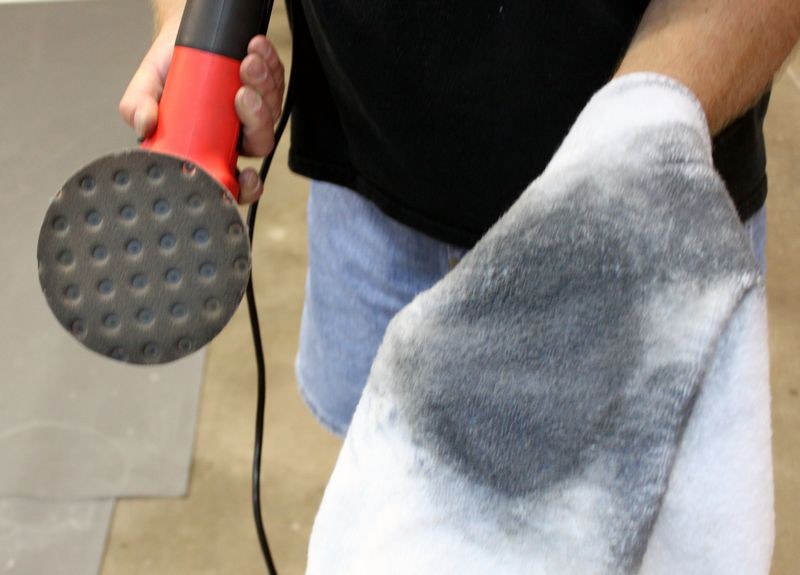
Remember....
Clearcoat paints are SCRATCH SENSITIVE - that means they will scratch easily.
So always, always always.... work clean....
Hope the above all helps....

-
Re: Removing slight DA haze/hologram
I started with an orange pad and UC on speed 4-5 to get out the scratches and the webbing, then moved on to a pink pad and UP on speed 3-4. This is on factory black paint. I'm thinking part of the problem is I didn't clean the pad often enough (it is a big Tahoe) and the DA speed was too slow. My arm speed is ok and I didn't let the product dry on the surface. I'm going to give it a shot again tomorrow evening. You think the green pad and UP is too aggressive?
By the way, you're the man Mike! Thanks for all the tips.
-
Re: Removing slight DA haze/hologram
 Originally Posted by tooshort_128

I'm thinking part of the problem is I didn't clean the pad often enough (it is a big Tahoe) and the DA speed was too slow.
Try cleaning your pad after each section you buff. If you don't have a Pad Conditioning Brush like we sell on the AG store use a toothbrush and with the tool turned OFF simply scrape the bristle against the face of the pad. This will remove the majority of the loose stuff and you can do it very quickly so you can get back to work.
The terry cloth towel removes the gunk too but it also extracts some of the liquid that builds up inside the pad and this will help the pad to rotate better as saturated pads don't rotate well.
 Originally Posted by tooshort_128

You think the green pad and UP is too aggressive?
Test in a section where you can see haze right now. If it leaves a haze-free finish then use it, if not test the red pad.
It shouldn't take much to remove any haze left by the UC.
Keep us updated....

Similar Threads
-
By Mike Phillips in forum Ask your detailing questions!
Replies: 22
Last Post: 01-25-2018, 12:39 PM
-
By nomercy346 in forum Auto Detailing 101
Replies: 1
Last Post: 08-23-2016, 05:57 PM
-
By Bryan@AzDPC.com in forum Tricks, Tips and Techniques
Replies: 1
Last Post: 05-03-2016, 11:13 AM
-
By Fred Rickson in forum Auto Detailing 101
Replies: 3
Last Post: 04-14-2015, 07:25 PM
-
By bancha_ch in forum Auto Detailing 101
Replies: 9
Last Post: 12-23-2007, 08:54 AM
 Members who have read this thread: 0
Members who have read this thread: 0
There are no members to list at the moment.
 Posting Permissions
Posting Permissions
- You may not post new threads
- You may not post replies
- You may not post attachments
- You may not edit your posts
-
Forum Rules
|
| S |
M |
T |
W |
T |
F |
S |
| 31 |
1
|
2
|
3
|
4
|
5
|
6
|
|
7
|
8
|
9
|
10
|
11
|
12
|
13
|
|
14
|
15
|
16
|
17
|
18
|
19
|
20
|
|
21
|
22
|
23
|
24
|
25
|
26
|
27
|
|
28
|
29
|
30
| 1 | 2 | 3 | 4 |
|












 Thanks:
Thanks:  Likes:
Likes:  Dislikes:
Dislikes: 

 Reply With Quote
Reply With Quote










Bookmarks